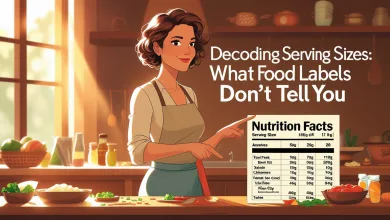How to Read Nutrition Labels: Complete Guide for Weight Management

Confused by the numbers and percentages on food packages? Our complete guide breaks down how to read nutrition labels for effective weight management, turning you from bewildered shopper to informed consumer in no time.
Nutrition Labels: Your Weight Management Secret Weapon
Let’s face it, those little black and white panels on food packages can be downright intimidating. All those numbers, percentages, and scientific-sounding ingredients might as well be written in hieroglyphics for many of us! But here’s the kicker—mastering how to read nutrition labels might just be the game-changer you’ve been looking for in your weight management journey.
Think of nutrition labels as your personal roadmap to making smarter food choices. They’re not just regulatory requirements; they’re powerful tools that put you in the driver’s seat of your dietary decisions. According to the FDA, nutrition labels were standardized precisely to help consumers make informed choices about the foods they eat. And when it comes to managing your weight, information truly is power!
The Anatomy of a Nutrition Label
Holy moly, there’s a lot packed into those little panels! But don’t worry—once you break it down, it’s not nearly as complicated as it seems at first glance.
Nutrition labels follow a standardized format that includes serving information, calorie content, and nutrient information. The FDA updated these labels in 2016 to make them more relevant to how people actually eat today and to emphasize certain elements that are important for public health.
Serving Size: The Foundation of Understanding
First things first—check that serving size! It’s crazy how many people miss this crucial detail and end up completely misinterpreting the rest of the information. The serving size tells you what all the other numbers on the label are based on.
For example, if the serving size is 1/2 cup, but you typically eat 1 cup, you’ll need to double all the values on the label to know what you’re actually consuming. The 2016 FDA update required that serving sizes be more realistic to what people typically consume in one sitting, but it’s still something you should pay close attention to.
Calories: Not the Villain, But Worth Watching
Next up is calories—those little units of energy that can add up faster than you can say “weight management.” The calorie content is now in larger, bolder text on nutrition labels because, let’s be honest, when you’re managing your weight, this number matters!
But remember—calories aren’t the whole story. 200 calories of broccoli affects your body differently than 200 calories of candy. Still, keeping track of caloric intake versus output is fundamental to weight management. Research from the National Weight Control Registry shows that successful “weight loss maintainers” regularly monitor their caloric intake.
Nutrients to Focus On for Weight Management
When it comes to weight management, not all nutrients are created equal. Some are your best friends, while others… well, let’s just say they’re better in small doses.
The “Limit These” Squad
These are the nutrients that most Americans get too much of, and they can sabotage your weight management efforts if you’re not careful:
- Total Fat (especially Saturated and Trans Fats): While your body needs some fat, saturated and trans fats can contribute to weight gain and health problems. Studies show that trans fats, in particular, can increase abdominal fat even when total calorie intake remains the same.
- Sodium: While not directly related to calories, high sodium intake can cause water retention, making you feel bloated and affecting that number on the scale. The American Heart Association recommends no more than 2,300 mg per day, with an ideal limit of 1,500 mg for most adults.
- Added Sugars: This relatively new addition to nutrition labels is a biggie for weight management! Added sugars contribute zero nutrients but plenty of calories. The American Heart Association suggests limiting added sugars to no more than 6 teaspoons (25 grams) per day for women and 9 teaspoons (36 grams) per day for men.
The “Get Enough” Gang
These nutrients support overall health and can actually help with weight management:
- Dietary Fiber: This superstar nutrient slows digestion, helping you feel fuller longer. Studies show that people with higher fiber intakes tend to have lower body weights.
- Protein: The MVP of nutrients when it comes to weight management! Protein helps preserve lean muscle mass during weight loss and increases satiety, which can prevent overeating. Research published in the American Journal of Clinical Nutrition found that higher protein intakes support weight management efforts.
- Vitamins and Minerals: While they don’t directly impact weight, getting adequate vitamins and minerals ensures your metabolism functions optimally. Many weight-conscious individuals focus so much on calories that they miss out on essential nutrients.
Deciphering the Percent Daily Value (%DV)
Ah, those percentages on the right side of the label—what do they actually mean? The %DV shows how much of your daily recommended intake of each nutrient you’re getting from one serving of the food.
Here’s a quick rule of thumb:
- 5% DV or less is considered low (good for nutrients you want to limit)
- 20% DV or more is considered high (good for nutrients you want to get enough of)
For weight management, you might want to look for foods lower in %DV for calories, fats, and sugars, but higher in fiber and protein. Remember, these percentages are based on a 2,000-calorie diet, so if your caloric needs differ, your target percentages will too.
Ingredient List: The Unsung Hero of the Label
Don’t skip the ingredient list! It’s your window into what’s actually in your food, listed in descending order by weight. This means the first ingredient makes up the largest proportion of the food.
For weight management, some red flags to watch for in the ingredient list include:
- Multiple types of sugars (things ending in “-ose” or syrups)
- Refined grains instead of whole grains
- Hydrogenated oils (source of trans fats)
- Long lists of ingredients you can’t pronounce (often highly processed foods)
A study published in BMJ found that ultra-processed foods are associated with higher risks of overweight and obesity. The ingredient list helps you identify these heavily processed foods.
Special Claims and What They Really Mean
“Low-fat,” “reduced sodium,” “light,” “natural”—food packages are plastered with claims that sound great but can be misleading. When it comes to weight management, understanding these claims is crucial.
The FDA regulates some of these terms strictly:
- “Light” or “Lite”: Must contain 1/3 fewer calories or 50% less fat than the regular version
- “Low-calorie”: Contains 40 calories or less per serving
- “Low-fat”: Contains 3 grams of fat or less per serving
- “Reduced”: Contains at least 25% less of a nutrient than the regular version
But watch out! “Natural” isn’t strictly defined by the FDA, and “made with real fruit” could mean a tiny amount of fruit concentrate in an otherwise sugar-laden product.
And here’s the real kicker—”low-fat” products often compensate by adding more sugar to improve taste. This is why reading the whole nutrition label, not just focusing on one claim, is essential for weight management.
Practical Tips for Using Nutrition Labels in Your Weight Management Journey
Alright, now that you know what to look for, how do you actually use this information in your day-to-day life? Let’s get practical!
Comparison Shopping Made Easy
Nutrition labels make comparing similar products a breeze. When you’re choosing between two breakfast cereals, for instance, don’t just compare calories—look at serving sizes, fiber content, and added sugars too.
Create a mental checklist based on your specific weight management goals. If you’re following a higher protein, moderate carb approach, you might prioritize protein content and fiber while keeping an eye on added sugars.
Planning Balanced Meals with Label Information
Nutrition labels can help you construct balanced meals that support your weight management goals. For example, if you know your lunch is low in protein, you can select a higher-protein option for dinner.
Many successful weight managers use a technique called “calorie banking”—using nutrition labels to plan how to “spend” their calorie budget throughout the day. This approach has been shown to be more effective than trying to make decisions on the fly.
Common Nutrition Label Traps and How to Avoid Them
Even savvy label readers can fall into these common traps:
- The Health Halo Effect: When a food makes one health claim (like “organic” or “gluten-free”), we tend to perceive it as healthier overall and may consume more of it. Remember, gluten-free cookies are still cookies!
- Serving Size Manipulation: Some products that seem like single servings actually contain multiple servings according to the label. Always check!
- Front-of-Package Distractions: Colorful claims on the front can distract from less favorable nutrition information on the back. Always flip the package over!
- Overlooking Condiments and Additives: The nutrition label on your bread looks great, but what about the mayo, butter, or jam you’re adding? These can significantly impact your calorie intake.
Research from Cornell University found that people tend to underestimate the calorie content of “healthier-sounding” menu items by as much as 35%, which can derail weight management efforts.
FAQ: Your Burning Nutrition Label Questions Answered
Q: If I’m trying to lose weight, should I just focus on calories and ignore everything else?
A: While calories are important, focusing solely on them can lead to nutritionally poor choices. Foods with similar calorie counts can have vastly different nutrient profiles. Prioritize nutrient-dense foods that help you feel satisfied while managing calorie intake.
Q: Are “zero-calorie” foods really calorie-free?
A: Not necessarily! FDA regulations allow products with fewer than 5 calories per serving to be labeled as having zero calories. If you consume multiple servings, those “zero” calories can add up. This is especially relevant for items like cooking sprays and artificial sweeteners.
Q: How accurate are nutrition labels?
A: The FDA allows a margin of error of up to 20% for the information provided on nutrition labels. While this might seem concerning, focusing on overall patterns rather than precise numbers is more beneficial for long-term weight management.
Q: Should I avoid all foods with added sugars if I’m managing my weight?
A: Not necessarily. The key is moderation and context. A yogurt with some added sugar but high protein content might still be a good choice in the context of your overall diet. It’s about the big picture, not eliminating any single ingredient entirely.
Putting It All Together: Your Action Plan
You’ve made it! You’re now equipped with the knowledge to navigate nutrition labels like a pro and use them to support your weight management goals. Here’s your action plan:
- Start with the serving size to contextualize all other information
- Check calories but don’t fixate on them
- Focus on getting enough protein and fiber
- Limit added sugars, saturated fats, and sodium
- Use the ingredient list to identify highly processed foods
- Look beyond front-of-package claims to the actual nutrition facts
- Use labels for comparison shopping between similar products
- Remember that nutrition labels are tools, not rules
The most successful approach to weight management combines label literacy with an understanding of your own body’s needs and signals. As research from the National Weight Control Registry shows, people who successfully maintain weight loss over time tend to be consistent in their eating patterns and regularly monitor their food intake.
Final Food for Thought
Mastering how to read nutrition labels for weight management isn’t about obsessing over numbers—it’s about empowerment. It’s about walking into a grocery store and confidently making choices that align with your health goals, rather than feeling overwhelmed or misled by clever marketing.
Remember, your relationship with food is personal and complex. Nutrition labels are just one tool in your weight management toolkit, alongside physical activity, stress management, sleep, and many other factors. Use this knowledge as a guide, not as rigid rules that take the joy out of eating.
After all, sustainable weight management isn’t about short-term restrictions—it’s about building a lifestyle that nourishes your body and mind for the long haul. And understanding what’s in your food through nutrition labels is a powerful step in that direction.






